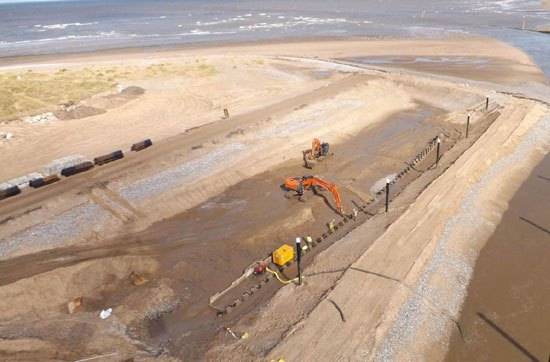Work to improve Welsh coastline gets a CEEQUAL rating of Excellent
Overview
In the Spring of 2012, a construction project to transform Rhyl and Foryd Harbour began. The main goal was to increase tourism and boosting the local economy. An integral part of this project was to provide a safer, more scenic route for pedestrians and cyclists as part of the Wales Coast Path which follows the entire coastline. The team who carried out the work got a CEEQUAL (now known as BREEAM Infrastructure) rating of Excellent (84.0%) for its sustainable practices.
About
Denbighshire County Council is the local authority for the county of Denbighshire, one of the principal areas of Wales. The council is based at County Hall in Ruthin.
Background
The contract was awarded to Dawnus Construction and the project management of the scheme was undertaken by Denbighshire County Council with an in-house design team undertaking the design of various elements of work, supplemented at various stages by external consultants. A major part of the project involved work on a stream that included a constructing a sustainable transport bridge, coastal erosion and flood protection works, harbour enhancements and the landscaping of the local areas.
Solutions
Physical resources: use and management
After exploring various walling materials that would match the visual scale and structural requirements needed, it was decided that CPM’s Redi-Rock™ walling would be used because of the resulting visual impact it would have and because of the cost incentives that the Redi-Rock positive connection walling offers. The one tonne blocks of 1070mm long, 457mm high and 710mm deep incorporated a Miragrid 10 XT, 20 XT and 24 XT geogrid reinforced earth system. Conventional solutions such as cladded sheet piles were considered, though the cost of sheet piles and the associated cladding made the scheme unviable.
The use of Redi-Rock™ walling allowed the contractor to install approximately 50 blocks over a tidal cycle, with the whole construction of the 188m long, up to 7.5m high quay wall being undertaken in just 30 weeks. Following close monitoring of the finished wall and backfill there has been no settlement and the Redi-Rock™ wall has withstood significant wave action during the recent storms and achieves the required design expectancy as well as looking good. The scheme has ended up being a flagship scheme for the regeneration of Rhyl and has met all targets set.
The wall comprises of:
- Sheet piles at the toe to prevent erosion
- Concrete foundations with mesh reinforcement
- Redi-rock positive connection blocks – over 5300 blocks placed
- Incorporating miragrid geogrids
- Granular backfill
Technology:
- Incorporates mass retaining wall design with reinforced earth designed
- It has been used in America by using American design codes
- First time used in the UK
Earthworks:
- 55,000m³ of material excavated
- 17,000m³ of material reused for reinforced earth backfill
- 14,000m³ of material reused as general fill to public square
- 24,000m³ of material reused to create additional and replenish sand dune system
Ecology and biodiversity
The project took place in a diverse ecological environment on the estuary of the River Clwyd. It involved the replenishment and extension of the sand dune system at Horton’s Nose habituated by common lizards; protected in the UK under the Wildlife and Countryside Act 1981, and classified as a Priority Species in the UK Biodiversity Action Plan. All sand to create the dunes was reclaimed from the bed of the Estuary. Once the profile of the dunes was created, they were set in place with jute matting and marram grass, which not only created additional habitat for the lizards but also mitigated against dust creation and dune erosion.
During the construction phase, the dune system also became home to nesting little terns, on the amber conservation list due to their vulnerable coastal nesting sites. The closure of an area of the beach to the public during the construction phase period and the general good maintenance of the area was thought to have attracted these rare, delicate seabirds. All works were programmed to avoid the nesting season and temporary works involved methods that protected the water environment. This construction included a sand/ silt bund for the extended quay wall and a land jetty was used to enable construction of the bridge central caisson without disruption from plant or pollution.
People and communities
Comprehensive community consultation took place on this project and meetings were held regularly with various harbour user groups. Local councillors and Welsh government ministers were regular visitors to the site. A very positive relationship was enjoyed and maintained with the only near neighbour of the project, Sunnyvale Caravan Park, who hosted the opening ceremony.
Volunteers were used to work on the dune system, erecting newt fencing pre-construction and planting marram grass. A manned visitors centre was offered adjacent to the site compound in partnership with the Harbour Master’s office throughout the construction phase, and displays were located in local commercial centres. The bridge was named through a competition for local school children and a local primary school was also given a tour of the site. Other benefits included jobs for two local operatives during the construction phase, a youth unemployment scheme, and local harbour users employed for safety boat operations. No complaints were received during the construction process and Dawnus consistently scored highly is Considerate Constructors Assesments.
Benefits
Reflecting on the impact of the CEEQUAL certification, a spokesperson for the project shared, “CEEQUAL took an active role in the direction of the project. It dictated not only a comprehensive list of targets for the team to attain but also helped create a strong and conscientious attitude of consideration to the general principles of the environmental, ecological and social effects of the project throughout the design and construction. The influence of CEEQUAL brought together all staff parties involved with the project in a singular and concentrated effort in order to achieve the sustainability rating.”


